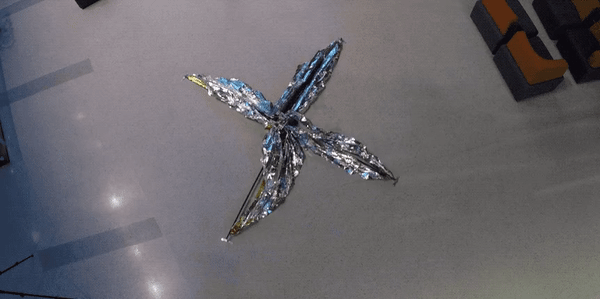'Drag sail' to deorbit satellites receives $750K in seed funding
Commercial sales of the Spinnaker drag sail may start as soon as 2023.

A "drag sail" concept designed to help get space junk out of orbit just received a cash infusion.
The Spinnaker concept to deorbit small satellites received $375,000 in seed funding from the investment firm Manhattan West, which NASA will match under its Small Business Innovative Research Phase II-Extended (SBIR Phase II-E) contract.
The combined $750,000 in funding will pivot Vestigo Aerospace's product line to commercial manufacturing, the company said in a Purdue University release, with the first sales expected in 2023. (The tech is licensed through Purdue.)
The money follows on from numerous discussions in the U.S. space community about space debris in recent weeks, including a fresh pledge to address the growing problem by the Federal Communications Commission and via policy from the Biden administration.
Related: Space junk removal is not going smoothly
"The Spinnaker product line of drag sails addresses the growing need for reliable end-of-mission deorbit capability … to maintain the sustainability of low Earth orbit," David Spencer, founder and CEO of Vestigo, said in the statement. "Bolt-on dragsails represent an 'ounce of prevention' approach to the orbital debris problem that, if left unchecked, could halt the growth of the orbital economy."
While the tech is early-stage, Vestigo did seek to test out its Spinnaker3 concept in orbit. However, that prototype was destroyed during the debut test flight of Firefly Aerospace's Alpha rocket, which ended with an explosion shortly after liftoff in September 2021.
Get the Space.com Newsletter
Breaking space news, the latest updates on rocket launches, skywatching events and more!
Once operational, the drag sail should be available for deployment on satellites regardless of whether they are functional or not, Vestigo said. "The drag sails can be deployed on command or via a backup timer, providing reliable deorbit capability even if the host vehicle is inoperative," the release stated.
Spinnaker isn't the only drag sail out there. The first spacecraft to demonstrate similar active space debris-removal technologies deployed from the International Space Station in 2018, and China tested a drag sail of its own in 2022.
Follow Elizabeth Howell on Twitter @howellspace. Follow us on Twitter @Spacedotcom or Facebook.
Join our Space Forums to keep talking space on the latest missions, night sky and more! And if you have a news tip, correction or comment, let us know at: community@space.com.

Elizabeth Howell (she/her), Ph.D., is a staff writer in the spaceflight channel since 2022 covering diversity, education and gaming as well. She was contributing writer for Space.com for 10 years before joining full-time. Elizabeth's reporting includes multiple exclusives with the White House and Office of the Vice-President of the United States, an exclusive conversation with aspiring space tourist (and NSYNC bassist) Lance Bass, speaking several times with the International Space Station, witnessing five human spaceflight launches on two continents, flying parabolic, working inside a spacesuit, and participating in a simulated Mars mission. Her latest book, "Why Am I Taller?", is co-written with astronaut Dave Williams. Elizabeth holds a Ph.D. and M.Sc. in Space Studies from the University of North Dakota, a Bachelor of Journalism from Canada's Carleton University and a Bachelor of History from Canada's Athabasca University. Elizabeth is also a post-secondary instructor in communications and science at several institutions since 2015; her experience includes developing and teaching an astronomy course at Canada's Algonquin College (with Indigenous content as well) to more than 1,000 students since 2020. Elizabeth first got interested in space after watching the movie Apollo 13 in 1996, and still wants to be an astronaut someday. Mastodon: https://qoto.org/@howellspace
